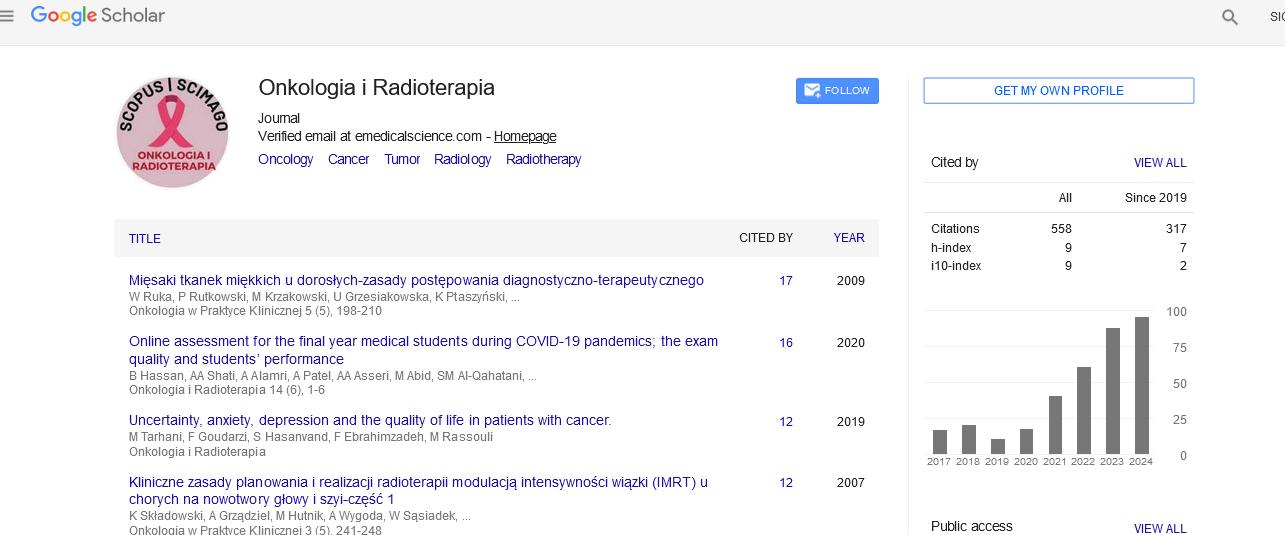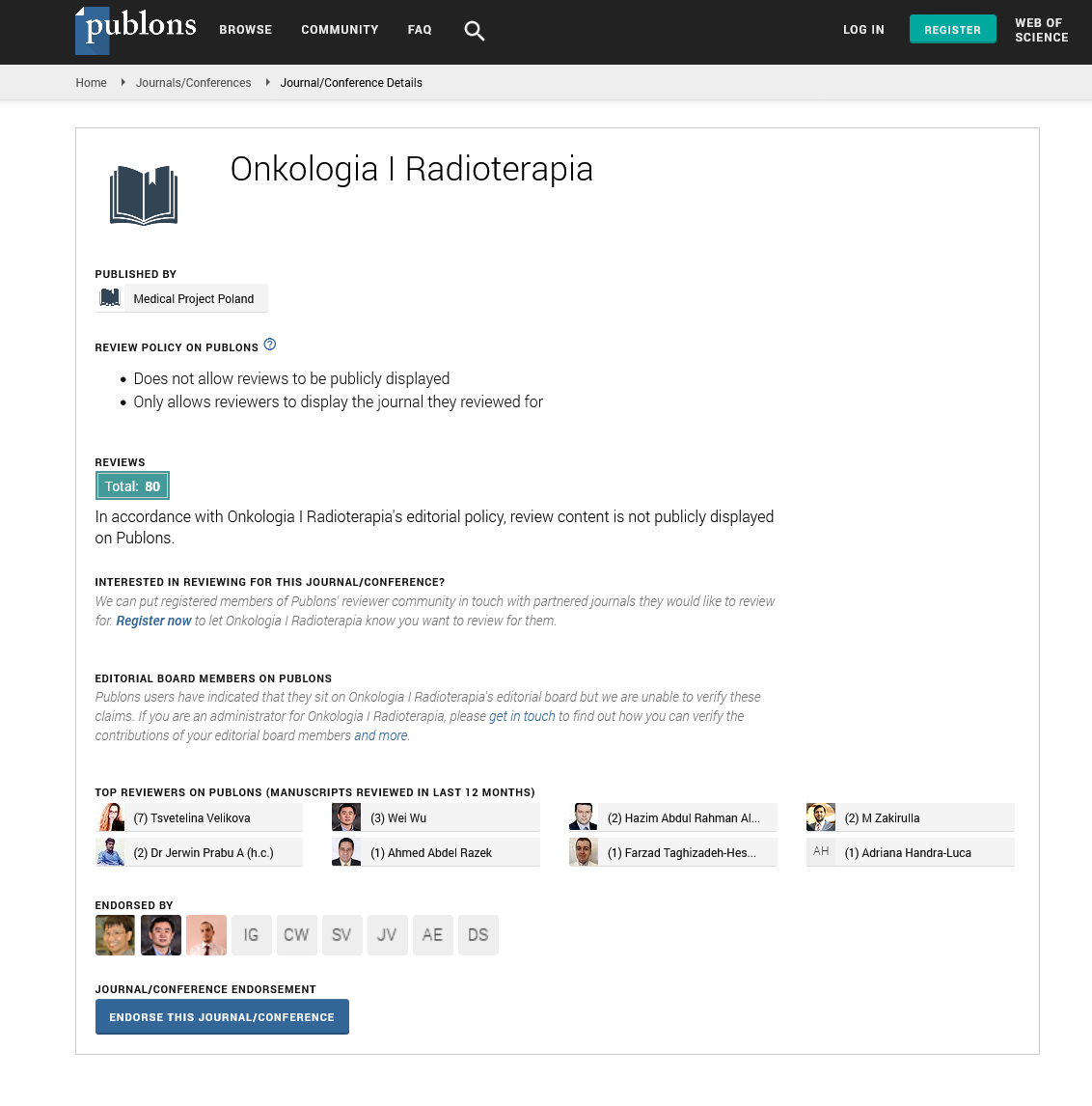Research - Onkologia i Radioterapia ( 2021) Volume 15, Issue 9
Closed versus open method in treatment of gluteal masses
Asaad Mohammed Kadhim1,2*, Mansour Amin Mohammad1,2 and Mamoon Othman Khalid12Department of Surgery, AL-Mawani Teaching Hospital, Basrah Health Directorate, Ministry of Health and Environment, Basrah, Iraq
Asaad Mohammed Kadhim, Department of Surgery, College of Medicine, University of Basrah, Basrah, Iraq, Email: yaalaalbairmany@gmail.com
Received: 14-Jul-2021 Accepted: 26-Aug-2021 Published: 27-Sep-2021
Abstract
Abscesses appear like hard lumps or masses surrounded by inflamed tissue. If it develops under the skin close to the anus, then it is known as a ‘gluteal abscesses. The present study was a hospital-based prospective study conducted in Al-Fayha Teaching and Al-Mwani Teaching Hospitals, between January 2020 to February 2021. Individuals with gluteal abscesses (n=100) were enrolled. They were divided into groups as gluteal abscess operated closed method (n=50), and gluteal abscess operated open method (n=50). In the close method operated surgery, about 36(72%) were male and 14(28%) were females. In the open method operated surgery, about 29(58%) were male and 21(42%) were females. About 3(6%) and 45(90%) patients were reported to have postoperative pain in the close and open method operated groups, respectively. Open method operated patients showed hospital stays for at least 4 days. Only, open method operated group showed healing by secondary intentions. About 5(10%) and 20(40%) patients were reported abscesses recurrent in the close and open method operated groups, respectively. In conclusion, the close method of the gluteal abscess surgery was found to be better, less painful with less than 10% recurrence rate
Keywords
gluteal abscess, open method, close method, necrotizing fasciitis, Staphylococcus aureus
Introduction
In the abscess, the pus is collected contain dead tissue, white blood cells and bacteria [1-3]. It appears as a hard lump surrounded by inflamed tissue [3]. The abscess can develop anywhere on the body, however, if it develops under the skin close to the anus, it is called gluteal abscess [4,5], which appear like a lump close to the anus.
Throughout the world, methicillin-resistant Staphylococcus aureus bacteria were reported to be very common in these abscess infections [2]. Recently, the information has not proved the effectiveness of routine irrigation of abscesses [6-8].
Previously, most studies were conducted upon superficial abscesses, especially at the sites was sufficient. This sufficiency facilitates the obliteration is an essential step of this technique. None of the reports was published regarding the comparison of close and open surgery methods for gluteal abscesses. With this background, we sought to evaluate the closed and open surgery methods in the treatment of gluteal abscesses on the basis of their postoperative outcome.
Material and Methods
Study design and setting
The present study was a hospital-based prospective study conducted in Al-Fayha Teaching and Al-Mawani Teaching Hospital between January 2020 to February 2021. Individuals with gluteal abscess (n=100) were enrolled. They were divided into two groups: gluteal abscess operated by closed approach (n=50) and gluteal abscess operated by open method (n=50).
Exclusion criteria
• Heart failure
• Leukaemia
• Steroid abuse
• Sickle cell anaemia
Ethical approval and patients consents
Ethical approval for the study had taken from the ethical committee of the College of the Medicine University of Basrah.
Surgery procedures
Closed method: The surgery was carried out under GA and prone positions or some time lateral positions. An adequate linear incision was applied. All the necrotic tissues and slough was discharged out. The inspection was done to exclude any side pool or necrotic tissues. In the wound, two redivac drains were put, and closed by nylon sutures. The Gouz dressing was applied over the wound, and it was being supported by adhesive straps. Postoperatively, one day, NS wash was applied to clean the wound. This maneuver make the patient comfort during wash and render the abscess cavity clean better than in open method. The procedure was followed for every 4 days. The stitches were removed on the 8th to 10th P.O. day. And the follow-up is done after one, six and twelve months.
Open method: The cruciate incision was made over the obvious part of the abscess. This procedure is referred to as ‘Incision And Drainage’ method (IND or I&D). The aim to perform to release the pressure caused by the production of excess fluid. Some abscesses have more than one pool of pus that must be ruptured to release all contents. When pus is drained, the wound is cleaned and rinsed with NS. The procedure can take 10 minutes to 45 minutes. It was dependent on the size and deepness of the abscess. The wound was left open and dressing was done daily.
Isolation and identification of the bacterial infection
The pus was collected from the abscess and diluted in the neutral saline (pH 7, 100 mM). Serial dilution was done and the planting was performed on the Luria Broth (LB) media. The plates were incubated at 37°C for 24 hr. The morphological characters were considered for bacteria identification.
Study parameters
At the time of anaesthesia induction, all patients received broadspectrum antibiotics. It was further continued after surgery for 7 days (oral antibiotics). After surgery, postoperative pain, hospital stay, needs surgical clinic visits and healing by secondary intentions were recorded for each patient. Recurrent abscesses, necrotizing fasciitis complications, need of heavy antibiotics and occurrence of ugly scar after healing was also recorded for all patients.
Results
In the present study, we operated 100 individuals with gluteal abscess in two procedures, viz. close method (n=50) and open method (n=50). In the close method operated surgery, about 36(72%) were male and 14(28%) were females. In the open method operated surgery, about 29(58%) were male and 21(42%) were females. The data regarding gender are depicted in Table 1.
| Groups | Male (%) | Female (%) |
|---|---|---|
| Close method | 36 (72%) | 14 (28%) |
| Open method | 29 (58%) | 21 (42%) |
Tab. 1. Gender distribution in each group
Around 45(90%) and 24(84%) patients showed less than 4cm abscess in the closed and open approach operated groups, respectively. Around 5(10%) and 26(52%) patients showed more than 4cm abscess in the closed and open method operated groups, respectively. The site of the abscess varied in both groups. However, both the groups showed maximum occurrence of abscess in the limb region (54% in close method and 34% in open method operated patients) (Table 2).
| Parameters | Variance | Close method | Open method |
|---|---|---|---|
| Size | <4cm | 45 (90%) | 24 (84%) |
| >4cm | 05 (10%) | 26 (52%) |
Tab. 2. Abscess size and occurrence site
Microbiological examination reveals that the mixture of bacteria were isolated from the pus drained from the gluteal abscess. In the close methods operated patients, none of the pus samples showed presence of bacterial infection. While, open method operated patients showed presence of S. aureus, S. viridans and other bacterial species (B. proteus, Pseudomonas, and E. coli). Hence, patients in this group were given antibiotics, postoperatively (Table 3).
| Parameters | Variance | Close method | Open method |
|---|---|---|---|
Microbiological examination |
S. aureus | 0 | 33% |
| S. viridans | 0 | 15% | |
| Other bacterial species (B. proteus, Pseudomonas, and E.coli) | 0 | 45% | |
| Not known | 5% | 7% | |
| Post-operative antibiotic use | -- | 0 | 100% |
Tab. 3. Microbiology and postoperative antibiotic use
Data regarding post-operative pain, hospital stays, need for a surgical clinic visit and healing by secondary intentions is depicted in Table 4. About 3(6%) and 45(90%) patients were reported to have postoperative pain in the close and open method operated groups, respectively. Open method operated patients showed hospital stays for at least 4 days. All patients in the open method operated group showed daily visits to a surgical clinic for at least 7 days for changing the dressing and gauze from the abscess cavity. All patients in the close method operated group showed visits to a surgical clinic every 4 days for assessment and normal saline washout from 2 redivac drains. Only, open method operated group showed healing by secondary intentions.
| Parameters | Variables | Close method | Open method |
|---|---|---|---|
| Post-operative pain | Yes | 3 (6%) | 45 (90%) |
| No | 47 (94%) | 5 (10%) | |
| Hospital stays | At least 4 days | -- | 100 (100%) |
| No | 100 (100%) | -- | |
| Need surgical clinic visit | Daily for at least 7 days | -- | 100 (100%) |
| Every 4 days | 100 (100%) | -- | |
| No | -- | -- | |
| Healing by secondary intentions | Yes | -- | 100 (100%) |
| No | 100 (100%) | -- |
Tab. 4. Assessment of post-operative parameters in both the groups
The data regarding abscesses recurrent, necrotizing fasciitis complications, the need for heavy antibiotics, dangerous structures to nearby lesions and ugly scars after healing are depicted in Table 5. About 5(10%) and 20(40%) patients were reported abscesses recurrent in the close and open method operated groups, respectively. About 7(14%) patients showed necrotizing fasciitis complications in the open method operated group. All patients in the open method operated group were shown heavy antibiotics requirements, dangerous structures to nearby lesions and ugly scars after healing. Criteria of complicated necrotizing fasciitis were development of crepitus. The patient showed toxic tachycardia and high degree fever with severe pain in and around the abscess wound.
| Parameters | Variables | Close method | Open method |
|---|---|---|---|
| Recurrent abscesses | Yes | 5 (10%) | 20 (40%) |
| No | 45 (90%) | 30 (60%) | |
| Complicated to necrotizing fasciitis | Yes | -- | 7 (14%) |
| No | 50 (100%) | 43 (86.00%) | |
| Need heavy antibiotics | Yes | -- | 50 (100%) |
| No | 50 (100%) | -- | |
| Dangerous method for nearby structures | Yes | -- | 50 (100%) |
| No | 50 (100%) | -- | |
| Ugly scar after healing | Yes | -- | 50 (100%) |
| No | 50 (100%) | -- |
Tab. 5. Assessment of secondary complications and abscesses recurrent in both the groups
Discussion
A study from Iraq revealed 60% of gluteal abscesses following intramuscular injections were associated with co-morbidities like diabetes mellitus, anaemia, jaundice, malignancy, and chronic steroid [9]. Nixon and Akoh did retrospective case review on the 117 patients for their efficiency of the superficial abscesses management [10]. The mean age of the enrolled patients were 38 years and operative time recorded as less than 30 minutes. In our study, we required around 10 to 45 minutes for incision and drainage abscess procedure. It was reported that about 11% patients required further antibiotic treatment and dressing care in the hospital. A number of patients required hospital stay for 3-4 days [10].
The closure technique depends on:
• Location of abscess
• Elimination of any sources of infection
• The abscess cavity wall must be curettage
• Abscess cavity space must be obliterating completely.
The abscess localization cavity was ensured by pre-operative application of an antibiotic around 48hr. This lead to the sterilization of the abscess peripheral area as well as further abscess gets stopped. This procedure surly localises the abscess. The infected abscess was also converted into sterile pus collection. An adequate incision helps to drain the entire abscess and permit a thorough inspection of the interior of the cavity. Curettage of the cavity done to cutting the so called barrier of spreading of the antibiotic. All residual spaces will be a site for serum or blood to be collecting and infected, and will fade to procedure failure. The complete obliteration helps to approximate the epithelial surfaces and granulation tissues for healing by primary intention. In the current study, antibiotics are continued till the removal of stitches. This is useful in the residual infection eradication.
Puthezhath et al. used repeated aspirations method to clean to abscission [4]. In the present study, we have used normal saline washout from 2 redivac drains. Kumar and Chandra reported a gluteal abscess case study in a child having tuberculosis of the sacrum with cauda equina compression. In this patients cold abscess spread along the aorta branches to reach the gluteal region [11]. However, in our study we have not focused on the route of gluteal abscess. Instead, we effectively showed that the closed method of the gluteal abscess surgery method was found to be better for the recovery.
Conclusion
In the close method of surgery, less postoperative pain, the minimum rate of abscess recurrence and required low dose of antibiotics as compared to the open method of gluteal abscess surgery.
Conflict of Interest
None.
References
- Seo H, Cha SI, Shin KM, Lim J, Yoo SS, et al. Focal necrotizing pneumonia is a distinct entity from lung abscess. Respirology. 2013;18:1095-1100.
- Singer AJ, Talan DA. Management of skin abscesses in the era of methicillin-resistant Staphylococcus aureus. N Engl J Med. 2014;370:1039-1047.
- Kuhajda I, Zarogoulidis K, Tsirgogianni K,Tsavlis D, Kioumis I, et al. Lung abscess-etiology, diagnostic and treatment options. Ann Transl Med. 2015;3:183.
- Puthezhath K, Zacharia B, Mathew T. Gluteal Abscess: Diagnostic challenges and management. J Infect Dev Ctries. 2010;4:345-348.
- Buyukoglan H, Gulmez I, Tutar N, Oymak FS, Kanbay A, et al. Gluteal abscess: An unusual complication of Bacille Calmette-Guérin. Ann Thorac Med. 2011;6:235-236.
- O'Malley GF, Dominici P, Giraldo P, Aguilera E, Verma M, Lares C, et al. Routine packing of simple cutaneous abscesses is painful and probably unnecessary. Acad Emerg Med. 2009;16:470-473.
- Chinnock B, Hendey GW. Irrigation of cutaneous abscesses does not improve treatment success. Ann Emerg Med. 2016;67:379-383.
- Dhar AD. Cutaneous Abscess. North Atlanta Dermatology. 2019
- Abdulla Hawramy T, Saeed KA, Salih Ahmed BH. Gluteal abscess, different intramuscular drug injections as causative agents. 3rd International Conference of Medical Sciences, Dubai. 2012.
- Nixon M, Akoh JA. Management of superficial abscesses: scope for day case surgery. Surg Res Pract. 2014;2014:308270.
- Kumar R, Chandra A. Gluteal abscess: a manifestation of Pott's spine. Neurol India. 2003;51:87-88.



